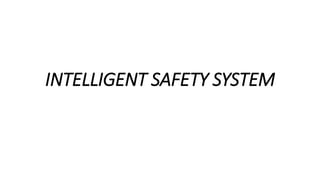
intelligent safety system.pptx
- 2. INTRODUCTION • An intelligent maintenance system (IMS) is a system that utilizes collected data from machinery in order to predict and prevent potential failures in them. • The occurrence of failures in machinery can be costly and even catastrophic. • In order to avoid failures, there needs to be a system which analyzes the behavior of the machine and provides alarms and instructions for preventive maintenance. • Analyzing the behavior of the machines has become possible by means of advanced sensors, data collection systems, data storage/transfer capabilities and data analysis tools.
- 3. • These are the same set of tools developed for prognostics. • The aggregation of data collection, storage, transformation, analysis and decision making for smart maintenance is called an intelligent maintenance system (IMS). •
- 4. DEFINITION • An intelligent maintenance system is a system that utilizes data analysis and decision support tools to predict and prevent the potential failure of machines. • The recent advancement in information technology , computers, and electronics have facilitated the design and implementation of such systems. • The key research elements of intelligent maintenance systems consist of: 1. Transformation of data to information to knowledge and synchronization of the decisions with remote systems
- 5. 2. Intelligent, embedded prognostic algorithms for assessing degradation and predicting the performance in future 3. Software and hardware platforms to run online models 4. Embedded product services and life cycle information for closed-loop product designs
- 6. E-manufacturing and e-maintenance • With evolving applications of tether-free communication technologies (e.g. Internet) e-intelligence is having a larger impact on industries. • Such impact has become a driving force for companies to shift the manufacturing operations from traditional factory integration practices towards an e-factory and e-supply chain philosophy. • Such change is transforming the companies from local factory automation to global business automation. • The goal of e-manufacturing is, from the plant floor assets, to predict the deviation of the quality of the products and possible loss of any equipment.
- 7. • This brings about the predictive maintenance capability of the machines. • The major functions and objectives of e-manufacturing are: “(a) provide a transparent, seamless and automated information exchange process to enable an only handle information once (OHIO) environment; (b) improve the utilization of plant floor assets using a holistic approach combining the tools of predictive maintenance techniques; (c) links entires Supply Chain Management (SCM) operation and asset optimization; and (d) deliver customer services using the latest predictive intelligence methods and tether-free technologies.
- 8. • The e-Maintenance infrastructure consists of several information sector: • Control systems and production schedulers • Engineering product data management system • Enterprise Resource Planning (ERP) systems • Condition monitoring systems • Maintenance scheduling (CMMS/EAM) systems • Plant Assest Management (PAM)systems
- 9. Hazard identification • A formal process of hazard identification is performed by the project team engineers and other experts at the completion of the engineering design phase of each section of the process, known as a Unit of Operation. • This team performs a systematic, rigorous, procedural review of each point of possible hazard, or "node", in the completed engineering design. • This review and its resulting documentation is called a HAZOP study. • A HAZOP study typically reveals hazardous scenarios which require further risk mitigating measures which are to be achieved by SIFs.
- 10. • Via a Layer of Protection Analysis (LOPA) or some other approved method, Integrity levels(IL) are defined for the SIFs in their respective scenarios. • The Integrity Levels may be categorized as Safety Integrity Level (SIL) or Environmental Integrity Level (EIL). • Based on HAZOP study recommendations and the IL rating of the SIFs; the engineering (including the BPCS and the SIF designs) for each unit operation is finalized.
- 11. System design • A SIS is engineered to perform "specific control functions" to failsafe or maintain safe operation of a process when unacceptable or dangerous conditions occur. • Safety Instrumented Systems must be independent from all other control systems the same equipment in order to ensure SIS functionality is not compromised.
- 12. Equipment • The correct operation of an SIS requires a series of equipment to function properly. • It must have sensors capable of detecting abnormal operating conditions, such as high flow, low level, or incorrect valve positioning. • A logic solver is required to receive the sensor input signal(s), make appropriate decisions based on the nature of the signal(s), and change its outputs according to user-defined logic. The logic solver may use electrical, electronic or programmable electronic equipment, such as relays, trip amplifiers or programmable logic controllers.
- 13. DIAGRAM